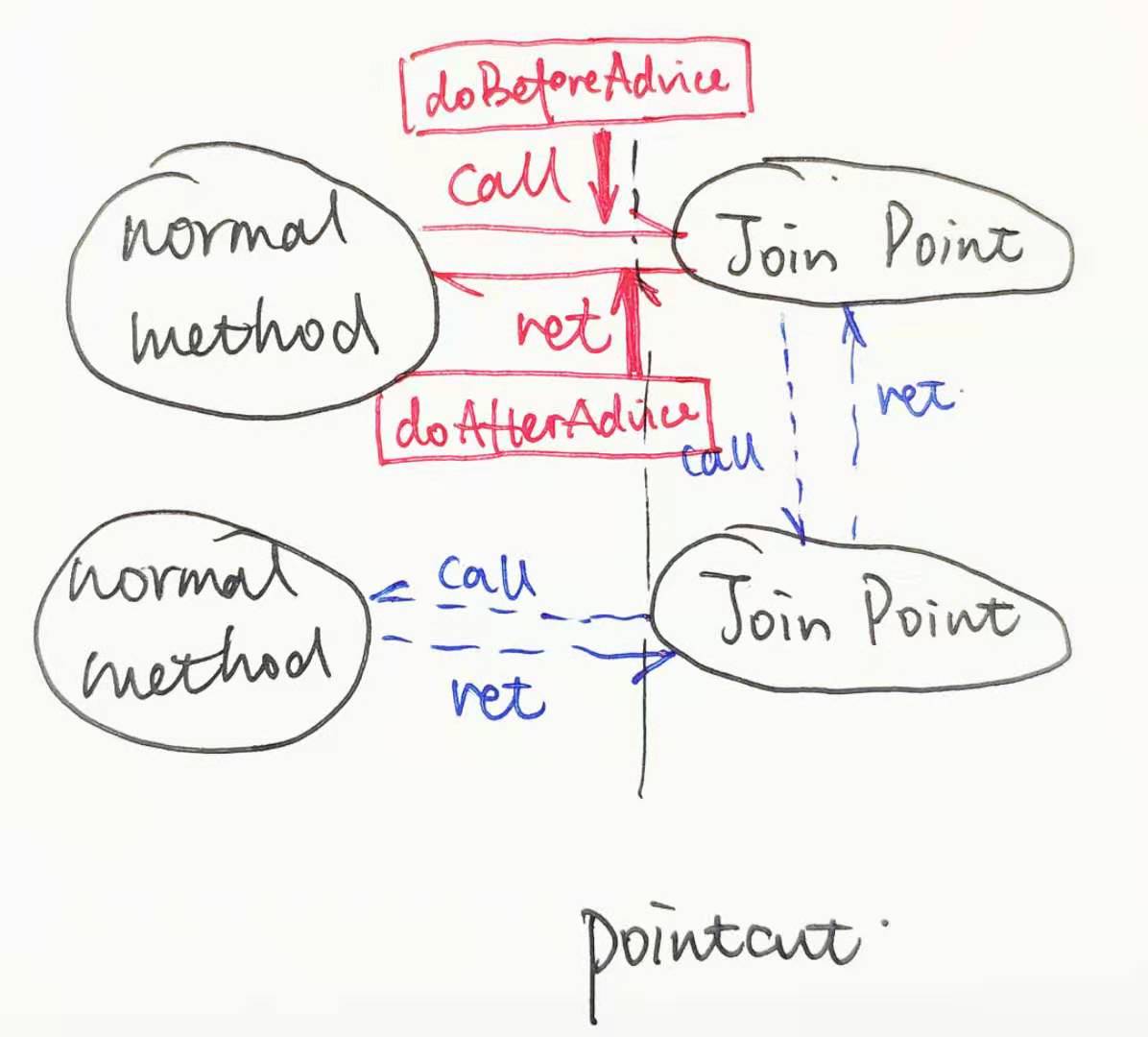Spring入门之AOP实践:@Aspect + @Pointcut + @Before / @Around / @After
零、准备知识
1)AOP相关概念:Aspect、Advice、Join point、Pointcut、Weaving、Target等。
2)相关注解:@Aspect、@Pointcut、@Before、@Around、@After、@AfterReturning、@AfterThrowing
一、实践目标
1)@Aspect的功能
2)@Pointcut的切面表达式
3)@Before、@Around、@After、@AfterReturning / @AfterThrowing的时序关系
4)AOP概念的重新梳理和使用
二、核心代码
MainController.java包含两个测试函数,分别是doSomething() 和 test()。
1 // MainController.java 2 @RestController 3 public class MainController { 4 RequestMapping(value="/doSomething", method = RequestMethod.POST) 5 @CrossOrigin("*") 6 public void doSomething() { 7 System.out.println("This is doSomething"); 8 test(); 9 } 10 11 @RequestMapping(value="/justTest", method = RequestMethod.POST) 12 @CrossOrigin("*") 13 public void test() { System.out.println("This is test");} 14 }
ExampleAop.java为AOP相关代码,定义了pointcut和多个Advice函数。
1 // ExampleAop.java 2 @Component 3 @Aspect 4 @Order(1) 5 public class ExampleAop { 6 7 private static final Logger LOGGER = LoggerFactory.getLogger(ExampleAop.class); 8 9 // 匹配com.example.demo包及其子包下的所有类的所有方法 10 @Pointcut("execution(* com.example.demo..*.*(..))") 11 public void executeService() { 12 } 13 14 @Before("executeService()") 15 public void doBeforeAdvice(JoinPoint joinPoint) throws Exception { 16 LOGGER.info("Before [{}]", joinPoint.getSignature().getName()); 17 } 18 19 @Around("executeService()") 20 public void doAroundAdvice(ProceedingJoinPoint joinPoint) throws Throwable { 21 LOGGER.info("Around1 [{}]", joinPoint.getSignature().getName()); 22 joinPoint.proceed(); 23 LOGGER.info("Around2 [{}]", joinPoint.getSignature().getName()); 24 } 25 26 @After("executeService()") 27 public void doAfterAdvice(JoinPoint joinPoint) throws Exception { 28 LOGGER.info("After [{}]", joinPoint.getSignature().getName()); 29 } 30 31 @AfterReturning("executeService()") 32 public void doAfterReturningAdvice(JoinPoint joinPoint) throws Exception { 33 LOGGER.info("AfterReturning [{}]", joinPoint.getSignature().getName()); 34 } 35 }
编译并运行jar包,调用接口/doSomething。
1 # 调用接口 2 curl localhost:8080/doSomething
到服务器观察日志。
1 <!-- 后台日志 --> 2 com.example.demo.aop.ExampleAop : Around1 [doSomething] 3 com.example.demo.aop.ExampleAop : Before [doSomething] 4 This is doSomething 5 This is test 6 com.example.demo.aop.ExampleAop : Around2 [doSomething] 7 com.example.demo.aop.ExampleAop : After [doSomething] 8 com.example.demo.aop.ExampleAop : AfterReturning [doSomething]
三、分析与结论
1)@Aspect的功能
在连接点的前后添加处理。在本例中,doSomething() 是连接点,而test() 不是。
是否只有最外层的joinpoint才会被Advice插入?在后面进行简单的探讨和猜测。
2)@Pointcut的切面表达式
ref: https://www.jianshu.com/p/fbbdebf200c9 完整表达式
@Pointcut("execution(...)") 是Pointcut表达式,executeService() 是point签名。表达式中可以包含签名的逻辑运算。
常用表达式:
1 execution(public * com.example.demo.ExampleClass.*(..)) // ExampleClass的所有公有方法 2 execution(* com.example.demo..*.*(..)) // com.example.demo包及其子包下的所有方法 3 logSender() || logMessage() // 两个签名的表达式的并集
3)@Before、@Around、@After、@AfterReturning / @AfterThrowing的时序关系
@Around1 -> @Before -> 方法 -> @Around2 -> @After -> @AfterReturning / @AfterThrowing(时序问题后面有额外讨论。)
另外可以发现,@Around是可以影响程序本身执行的,如果不调用 joinPoint.proceed(); 就不会执行方法。其他几个都无法影响程序执行。
4)AOP概念的重新梳理和使用
Aspect(切面):使用了@Aspect注解,如ExampleAop类。
Advice(增强):在指定位置进行的增强操作,如方法运行时间统计、用户登录、日志记录等。由@Before、@After等注解标注,如doBeforeAdvice() 方法。
Weaving(织入):AOP就是一种把Advice织入(即嵌入、插入)到Aspect中指定位置执行的机制。
Join point(连接点):Advice执行的位置,也是Advice的参数,是一个具体的方法。如日志中看到的doSomething() 函数。
Pointcut(切点):以表达式的形式表示一组join point,用于由@Pointcut注解定义Advice的作用位置。如@Pointcut("execution(* com.example.demo..*.*(..))") 代表com.example.demo包及其子包下的所有类的所有方法。
Target(对象):被增强的对象,即包含主业务逻辑的类的对象,如ExampleAop类的实例。
四、疑问与讨论
1. 本文说执行顺序为@Around1 -> @Before -> 方法 -> @Around2 -> @After,但有的文章中说是@Before -> @Around1 -> 方法 -> @Around2 -> @After,也有说@Around1 -> @Before -> 方法 -> @After -> @Around2,哪个对?
反正代码跑起来是这个顺序,那就是这个顺序喽。每个Advice都加上sleep拉开时间也没有变化。不知道是否受版本或代码自身影响。
总之可以得到一个结论:@Before / @After 最好不要和@Around混用,执行顺序不好确定。
时序至少总是满足:@Around1 / @Before -> 方法 -> @Around2 / @After -> @AfterReturning / @AfterThrowing
另外找到一篇支持本文执行顺序的文章:https://blog.csdn.net/qq_32331073/article/details/80596084
2. 为何doSomething() 和 test() 都是@Pointcut中选中的作用节点,但只有doSomething() 插入了Advice,而test() 没有呢?
一个猜测:从字面意思理解,@Pointcut对所有代码以表达式为规则剪一刀,一侧是所有的joinpoint,另一侧是普通代码。在joinpoint与另一侧代码间插入一层Advice的代理,另一侧的代码如果要调用joinpoint,则必须经Advice进行增强操作。而不同的joinpoint在同一侧,因此未插入Advice。
有时间再读源码了解其中的机制。

(一个猜测)
五、Future Work
1. AOP中还有Advisor等概念,待学习。
2. 切面表达式(@Pointcut里的表达式)规则丰富,待学习。
3. Advice的插入时机,待读源码学习。



